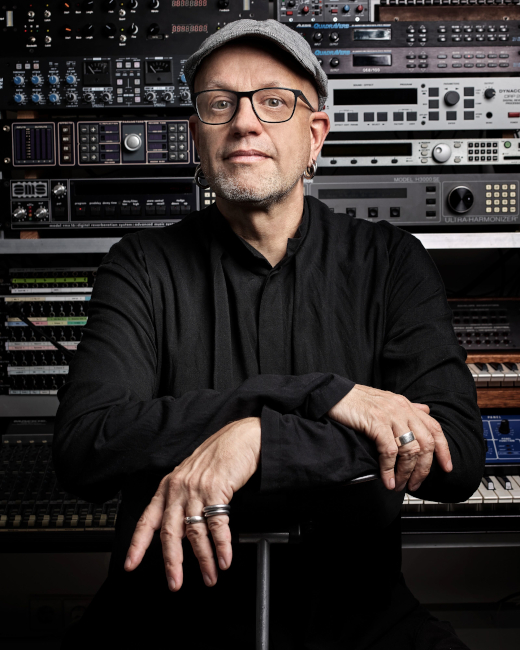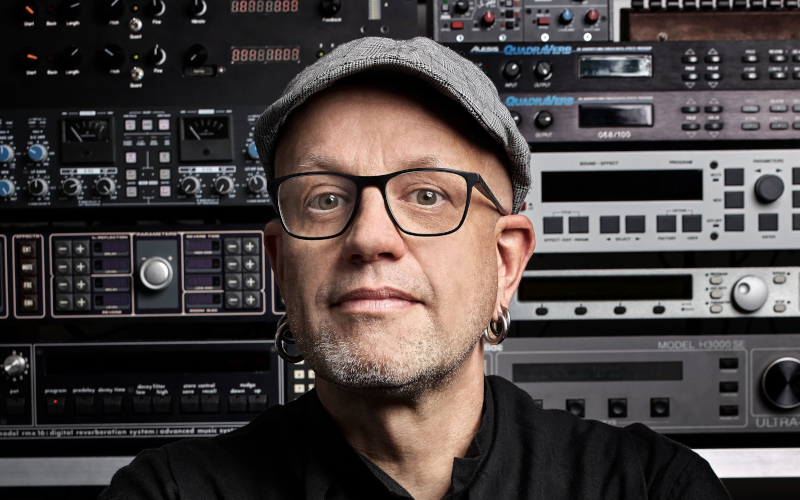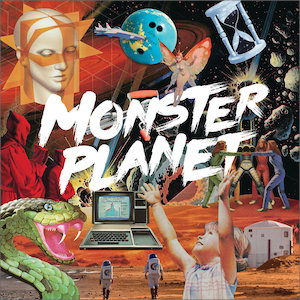
Yes! What is that? Where was that coming from? I’ve never heard that in your music before, and it’s brilliant.
RH :: It’s really, really funny. We all have our instruments that we love and that we know inside out. And we have also a certain… I mean, everyone has a certain idea of which sounds they like. I’m always into this really more dark, inharmonic, bell type of sounds. I was never, ever a fan of this Oberheim brass things.
(Pointing to an Oberheim Xpander behind Henke on screen, one of the most lauded and sought after of vintage analog synthesizers) And yet I see behind you…
RH :: (LAUGHS) Yeah. Well, that’s just it exactly! As a teenager of the ’80s, of course, I wanted to have all these instruments that I could not afford. I wanted to have an Emulator, and I wanted to have a PPG and all that stuff. Then probably thirty years ago I got an offer for that Oberheim Xpander. At this time it was that cheap because with only six voices and being analog no one cared. I paid, I don’t know, a ridiculously low amount of money for it. But we never became friends. I admire it from a technical perspective. I love the interface design. I love how it looks. I admire the complexity, but it never clicked with me sonically. But I also never felt I could sell it simply because it’s such a beautiful instrument. For the end of “Red Alphonso,” I was looking at this big sound, and I was trying the usual suspects here. I also used Operator and other things. But I felt something was missing. I don’t know what prompted me. I thought, “Let’s add a layer of the Xpander.” The first preset I opened was this brass sound, and I added a little bit of reverb and filtering, and I thought, This is great.
That’s amazing!
RH :: After using an instrument for 20 years and not getting along, suddenly, there’s this revelation of “Now I get it!”
It comes through well. And I totally understand that feeling of wanting all the gear I saw in music magazines back in the ’80s, pining after whatever Depeche Mode, New Order or Kraftwerk were using. But having that synth for ages and finally cracking something about it is very powerful. It shows through there. I don’t know if you’re familiar with a musician from Wuppertal whose name is Martin Stürtzer. He works in a couple styles but mostly these Klaus Schulze, Kosmische-inspired stuff that’s beautiful. He does regular livestreams which I love. My three favorite things about them are that his cat Neptune is often on camera and occasionally improvises on the controller keyboard for him whether he wants it or not. And his Xpander is usually prominent in the background. Now I don’t want to sound like some dirty old pervert on the Reeperbahn going, “Oh, touch it.”
RH :: (LAUGHS) “Touch it.”
But at the same time, it really does do beautiful things when you do touch it.
RH :: Yeah, and it’s so great.
I love that you said “It was the first preset I put on some reverb and it’s beautiful.” I think a younger man might say, “Well, I spent 12 days going through each Xpander patch’s entire parameter list until I hit the very last one and I was about to sell it but then it saved the album.” Apropos of nothing a couple of years ago my father passed away and I inherited a small sum of money. I said, “Well, okay, now I can buy all the synths I’ve ever wanted!” But I promised myself and my wife I’d only buy them on sale. So I bought some classics like a Roland SH-09. But my one big ticket item was a Waldorf Iridium.
RH :: Okay, which is super complex, and you can spend the rest of your life working with it.
That’s my plan! I’m like, “I’ve probably got 30 maybe 40 years left if I’m lucky, eat right and keep exercising. By then, I will have figured out the Iridium.” (LAUGHS)
RH :: (LAUGHS) I think this is also, I guess, again, it’s maybe a question of generation because when I started to make music, the only thing I could afford was a used Juno 6. I had a cassette deck and a Walkman. I built myself a small mixer so that I could do this ping-pong with the tracks, recording to my cassette deck, put it into the Walkman, which slightly detuned it because it went at a different speed. I had to retune the Juno 6. Mix these both things together, lost a generation, added noise. But of course, by doing this, I learned a certain appreciation for getting the maximum out of a small setup. Now today I know a lot more about music in general and my tools. I lost a lot of innocent exploration but I gained much more skills to go deeper into things. For instance I am very pleased with how mixing this album worked out. I never felt more in control of the overall sound and I never had more fun adjusting details in a meaningful way and noticing the difference this makes. This feeling of knowing what to do is very empowering.
Yeah. Truly. I love what you just said about learning to do with only a small amount of things, of devices. Back in the day it was all hardware. Then I started using an old Mac running StudioVision Pro then went to Logic Pro for a bit then was strictly Ableton. Still mostly in the box now though I’ve been transitioning back to hardware for livestreams. What’s fascinating is that having owned four vintage SH-101s, the SH-01A boutique synth is such an amazing improvement. But it’s like you said, it’s like the Juno 6. It has that beautiful drift. There’s that type of thing that even the most detailed AI approximation of the Juno is never going to get at.
RH :: Also, there is a certain, I would almost say, intimacy that you develop with your instrument because you are standing or sitting in front of a physical object and you’re forgetting everything else. I like that. Again, if I’m sitting in front of the expander, it’s just that. It’s not that right behind it is not an email client.
Yeah, exactly. It’s been interesting for me to notice a transition over the years from, “Oh, guy with a laptop on stage is making cool music live!” to a person using a laptop on stage and people say, “Oh, are they reading their email?” It’s almost like a generational shift. When people started talking about their DAW-less jams, I’m old enough to remember when there was no such thing because there was no such thing as a digital audio workstation.
RH :: You are the DAW essentially.
Exactly! Now I remember an interview in The Wire with Iannis Xenakis where he said that day he’d watched a brand new machine fail to work and he was understandably very sad and upset at the lost time. That made me realize that with the advent of electronic music with musicians like Keith Emerson, Tangerine Dream and others they became engineers as well as musicians. You have a very different background because you come from the audio mastering and engineering so I wonder if you see yourself as a musician or an engineer or an artist? An alchemist? A house painter? (Laughs)
RH :: Well, I need to make a slight detour. And the slight detour is I found it very fascinating that in our Western society since a few hundred years with the advent of “science,” there was a necessity to separate science from, let’s say, non-science, to separate science from religion. To say, “Okay, this is a belief, and this is something that we can methodologically prove.” It’s historically completely understandable why this separation was necessary. But on the way it happened that there was also a separation between the arts and science. And this is, to a certain degree, understandable for exactly the reasons I said, that the aim of science is you want to come to an absolute truth. So you want to approximate something that you can verify, and then you can put in numbers. In the arts, there’s nothing like that. Because I cannot say, unfortunately, “This is only 95%.” Actually, it’s 95.7%. Because it is what it is. And in science, I prove a theory or I can’t prove it. And there’s some clarity there. So for a long time, I felt I needed to make a decision between (whether) I’m an engineer or I’m an artist. And it took me way too long to understand that good engineering has something to do with imagination. And with good engineering measuring has something to do with a willingness to think about the unthinkable.
If you look inside a 1980s Hewlett-Packet measuring tool, and you see what these engineers there managed to do, and for someone who understands enough about it, I’m struck. I’m like, “What the fuck? This is brilliant. This is insane!” And an interesting part of history: there was one person who worked as an engineer for Hewlett-Packard, and who was also completely amazed by Hewlett-Packet as a company because they were so innovative and they were so artistic in what they’re doing, that when a friend of his tried to convince him to found their own company, at the beginning, he said no. And that was a certain Steve Wozniak.
Oh, wow. That’s great.
RH :: There is an artistic mindset inside the Apple, too! It is the artistic mindset of the artistic genius of a Steve Wozniak who manages to boil down functions to the least parts possible. And this is creative.
It is. Thank you for sharing that. That’s brilliant. It truly is.
RH :: And for me, I like engineering and I like science because it’s inspiring. And so much of what I’m doing in my artistic practice has to do with the fact that I need to understand a few technical things in order to make it work, or that I need to count bars because I know that a certain regular pattern makes more sense.













![Pole :: Tempus Remixes (Mute) — [concise]](https://igloomag.com/wp/wp-content/uploads/2025/04/pole-tempus-remixes_feat-75x75.jpg)






![Hasbeen :: Bunker Symphonies II (Clean Error) — [concise]](https://igloomag.com/wp/wp-content/uploads/2025/04/hasbeen-bunker-symphonies-ii_feat-75x75.jpg)
